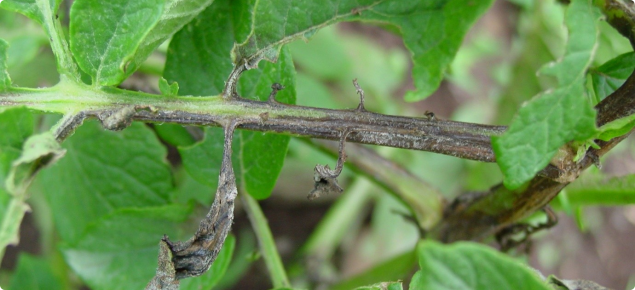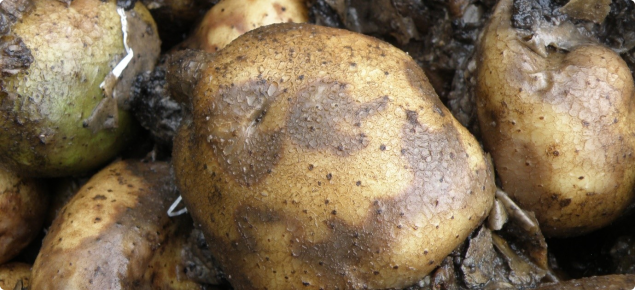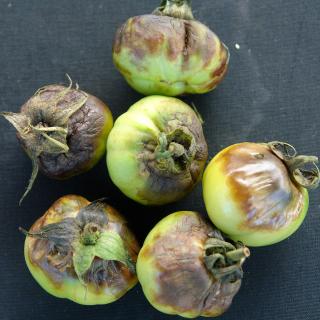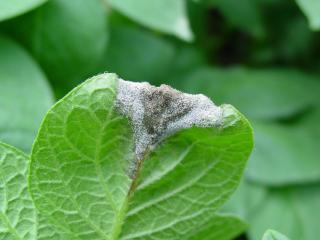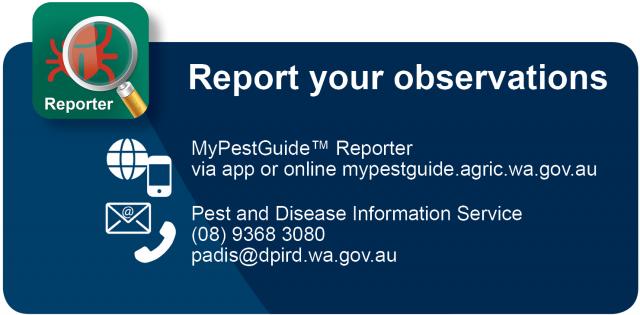Plants affected
The main hosts of late blight are potato and tomato. Closely related crops such as capsicum and eggplant are also mildly affected. Other hosts are common garden petunia, Japanese morning glory (Ipomoea nil), tobacco and the weed blackberry nightshade (Solanum nigrum).
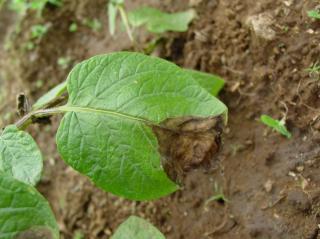
What to look for
- Large, pale green areas form on potato or tomato leaves which become watersoaked and dark
- Lesions expand rapidly and the whole leaf can die.
- When conditions are wet and humid late blight produces spores which are easily seen on the underside of the lesion as a white fluffy “down”.
- Lesions and sporulation can also occur on the stems of plants.
- Potato tubers can be affected with a tan-brown, reddish or purplish rot that penetrates about 1.5cm into the tuber.
- Other fungi and bacteria often invade tubers that are infected by late blight, and the whole tuber breaks down.
- Tubers that seem healthy when harvested can rot later in storage.
- Firm dark brown lesions form on tomato fruit and these can grow quickly and destroy the whole fruit.
Survival and spread
- Late blight causes serious epidemics when the weather is suitable.
- Wet, humid weather coupled with temperatures around 21°C favour rapid development of late blight.
- Late blight is usually introduced to new areas with seed potatoes. It can be present even if the seed looks healthy.
- Spores form on infected leaves and these can be splashed by rain onto nearby plants or carried up to 20km by wind.
- Tubers are infected when spores are washed down into the soil from infected foliage.
- Late blight can survive between crops on plant residues.
Damage
Late blight is one of the most serious diseases of any crop worldwide. In favourable weather, late blight completely destroys potato foliage in a few days and infected tubers rot in storage.
There are two types of late blight, called mating type A1 and mating type A2. The combination of the A1 and A2 mating types has produced more aggressive strains of the pathogen and enables sexual reproduction to occur which helps the disease survive better in the soil and become resistant to fungicides.
Old A1 mating type late blight is already present in some states of Australia, but not in Western Australia. The A2 mating type and new aggressive strains of the A1 mating type are not present in any part of Australia but are present in a number of neighbouring countries in south east Asia.
Status in Western Australia
Phytophthora infestans (Mont.) de Bary, 1876 is considered absent from Western Australia and is a quarantine pest.
It is a prohibited organism under section 12 of the Biosecurity and Agriculture Management Act 2007.
Western Australia's Pest Freedom for late blight is supported by general and specific surveillance (including potato seed certification), specific import requirements to prevent its entry, and legal requirements to report any occurrences of the pest.
Report suspect disease
It is important that any suspect disease occurrence is reported. Early detection and eradication will help protect Western Australian potato and tomato growers. Please make a report using MyPestGuide or contact the Pest and Disease Information Service (PaDIS) to report this pest.



